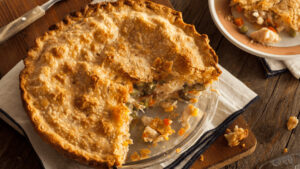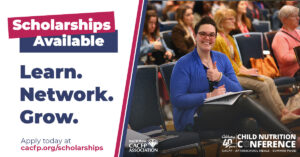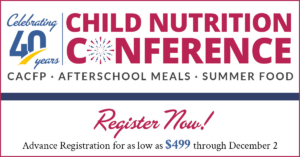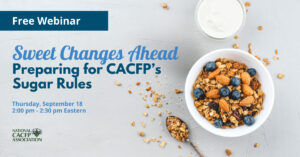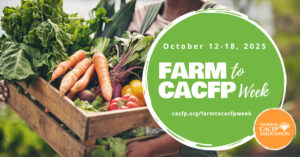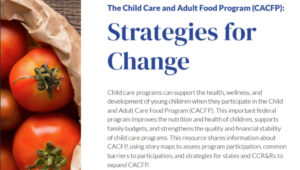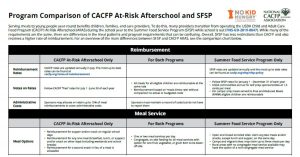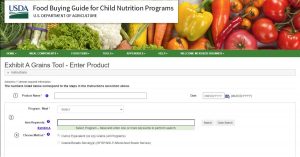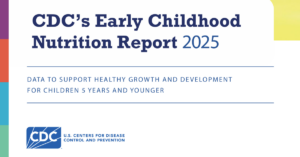Can a parent or guardian supply a meal component for their infant in the infant meal pattern?
Read MoreCould the crust of a chicken pot pie credit as the grains component?
Read MoreDiscover how your organization can help close the summer nutrition gap through USDA’s SUN Meals, also know as the Summer Food Service Program.
Read MoreAre juice cocktails creditable in the CACFP?
Read MoreThe National CACFP Association (NCA) is proud to continue its annual scholarship program for the 2026 National Child Nutrition Conference (NCNC), taking place April 13–17, 2026, in Las Vegas, Nevada.
Read MoreWe are closely monitoring the potential government shutdown on October 1 and its impact on the CACFP. As your trusted partner, we’ll keep you informed with timely updates.
Read MoreOver 2,000 key stakeholders and professionals from the Child and Adult Care Food Program (CACFP) and Summer Food Service Program community will convene for a week of nutrition education and professional development at the 40th annual National Child Nutrition Conference (NCNC) in Las Vegas, Nevada, from April 13–17, 2026.
Read MoreRegistration for NCNC26 is now open! Get ready for our 40th Anniversary – five days of training, networking and fun.
Read MoreBeginning October 1, 2025, the Child and Adult Care Food Program (CACFP) will implement new regulations requiring limits on added sugars in breakfast cereals and yogurts served in child and adult care settings.
Read MoreThis October marks the inaugural Farm to CACFP Week, hosted by the National CACFP Association to celebrate the benefits of connecting child and adult care programs with local foods.
Read MoreThe USDA has released the Reimbursement Rates for 2024-2025. Rates are effective from July 1, 2024, through June 30, 2025.
Read MoreSince our last policy updated, there are new opportunities for you to advocate, in addition USDA has released two final rules, two pieces of guidance, and a data report on CACFP.
Read MoreNCA surveyed its CACFP sponsoring organization and provider members to obtain feedback on their experiences with the food program. NCA analyzed information collected from the survey in the State of the Child and Adult Care Food Program report.
Read MoreUSDA released a memorandum that provides updated guidance on the geographic preference option to reflect changes made by the final rule.
Read MoreSince 2019, Child Care Aware® of America (CCAoA) and Nemours Children’s Health have partnered to create geographic information system (GIS) technology story maps to visualize CACFP participation and highlight communities that could be considered for CACFP expansion.
Read MoreDuring the entire month of August, every congressional elected official will be back in their home state or district. Don’t miss this opportunity to advocate for CACFP! Showcasing your program is one of the most impactful ways to advocate for the CACFP.
Read MoreExciting news! Head Start programs have an opportunity to access one-time supplemental funds to support nutrition services and healthy eating for enrolled children and families. You can use this funding for staff training on resources and educational opportunities to help your program improve outcomes for children and families and align with USDA requirements – like the CACFP!
Read MoreThe Child and Adult Care Food Program has new creditable foods listed on the USDA Food Buying Guide! If you are new to the FBG, this interactive tool allows for easy display, search, and navigation of food yield information. In addition, users can compare yield information, create a favorite foods list, and access tools, such as the Recipe Analysis Workbook (RAW) and the Product Formulation Statement Workbook.
Read MoreThe Child and Adult Care Food Program community asked for more Spanish resources to be available on the National CACFP Sponsors Association website and we heard you! Available now in Spanish are more resources to help sponsors and providers with meal pattern requirements, best practices, and so much more!
Read MoreServing meals to young people year-round benefits children, families, and care providers. To do this, many providers transition from operating the USDA Child and Adult Care Food Program (CACFP) At-Risk Afterschool (ARAS) during the school year to the Summer Food Service Program (SFSP) while school is out. For an overview of the main differences between SFSP and CACFP ARAS, see the comparison chart below.
Read MoreNCA understands that the end of flexibilities will cause challenges for many CACFP sponsors and providers and we commend your continued commitment to providing nutritious meals and snacks to the children or adults in your care. In preparation for the end of the additional reimbursement, we have collected the following resources to help you successfully provide meals even if your available budget decreases.
Read MoreCan a parent or guardian supply a meal component for their infant in the infant meal pattern?
Read MoreCould the crust of a chicken pot pie credit as the grains component?
Read MoreAre juice cocktails creditable in the CACFP?
Read MoreIs raw cow’s milk creditable in the CACFP?
Read MoreDoes mixing fresh fruits into yogurt count towards added sugars?
Read MoreCan breakfast cereals ever be considered a grain-based dessert?
Read MoreExciting news! Head Start programs have an opportunity to access one-time supplemental funds to support nutrition services and healthy eating for enrolled children and families. You can use this funding for staff training on resources and educational opportunities to help your program improve outcomes for children and families and align with USDA requirements – like the CACFP!
Read MoreThe Child and Adult Care Food Program has new creditable foods listed on the USDA Food Buying Guide! If you are new to the FBG, this interactive tool allows for easy display, search, and navigation of food yield information. In addition, users can compare yield information, create a favorite foods list, and access tools, such as the Recipe Analysis Workbook (RAW) and the Product Formulation Statement Workbook.
Read MoreThe Child and Adult Care Food Program community asked for more Spanish resources to be available on the National CACFP Sponsors Association website and we heard you! Available now in Spanish are more resources to help sponsors and providers with meal pattern requirements, best practices, and so much more!
Read MoreServing meals to young people year-round benefits children, families, and care providers. To do this, many providers transition from operating the USDA Child and Adult Care Food Program (CACFP) At-Risk Afterschool (ARAS) during the school year to the Summer Food Service Program (SFSP) while school is out. For an overview of the main differences between SFSP and CACFP ARAS, see the comparison chart below.
Read MoreNCA understands that the end of flexibilities will cause challenges for many CACFP sponsors and providers and we commend your continued commitment to providing nutritious meals and snacks to the children or adults in your care. In preparation for the end of the additional reimbursement, we have collected the following resources to help you successfully provide meals even if your available budget decreases.
Read MoreUSDA released their second report on the Study of Nutrition and Activity in Child Care Settings (SNACS-II), which follow their first in 2022. SNACS-II uses data from program year 2022-23 to assess how well children’s diets and CACFP meals align with the Dietary Guidelines for Americans.
Read MoreA recent study by our partners at Child Care Aware® of America reveals that parents across the nation are struggling to find affordable, high-quality child care. The survey shows that parents are piecing together multiple care arrangements and facing challenges balancing work and caregiving.
Read MoreThe CDC’s 2025 Early Childhood Nutrition Report gives us a big-picture look at how young children in the U.S. are eating and growing. It focuses on kids from birth to age 5 and shares important facts about breastfeeding, starting solid foods, eating healthy and how states support good nutrition.
Read MoreThe “Characteristics of Emergency Shelters Participating in the CACFP” study by USDA seeks to better understand the characteristics of CACFP emergency shelters, who they serve, how CACFP fits into their operations, and their challenges with CACFP. The study was conducted in 2023 and collected data from 242 emergency shelters that participate in CACFP in Fiscal Year 2023.
Read MoreA survey was administered in the spring of 2023 of licensed California family child care homes (FCCH) to assess the perceived impacts of the increased reimbursement during the Covid-19 pandemic on CACFP participation and anticipated challenges with reinstated tiered rates.
Read MoreThe USDA recently released a study on the “Characteristics of Adult Day Care Centers that Participate in the USDA’s Child and Adult Care Food Program” which seeks to better understand key characteristics of adult day care centers participating in CACFP.
Read More


